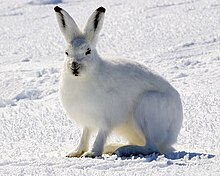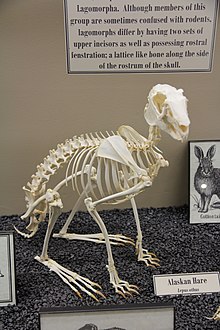| Rabbits and hares[1] | |
|---|---|

| |
| Arctic hare (Lepus arcticus) | |
| Scientific classification | |
| Domain: | Eukaryota |
| Kingdom: | Animalia |
| Phylum: | Chordata |
| Class: | Mammalia |
| Order: | Lagomorpha |
| Family: | Leporidae Fischer de Waldheim, 1817 |
| Type genus | |
| Lepus Linnaeus, 1758
| |
| Genera | |
|
Pentalagus | |

Leporidae (/ləˈpɔːrɪdiː, -daɪ/) is the family of rabbits and hares, containing over 70 species of extant mammals in all. The Latin word Leporidae means "those that resemble lepus" (hare). Together with the pikas, the Leporidae constitute the mammalian order Lagomorpha. Leporidae differ from pikas in that they have short, furry tails and elongated ears and hind legs.
The common name "rabbit" usually applies to all genera in the family except Lepus, while members of Lepus (almost half the species) usually are called hares. Like most common names, however, the distinction does not match current taxonomy completely; jackrabbits are members of Lepus, and members of the genera Pronolagus and Caprolagus sometimes are called hares.
Various countries across all continents except Antarctica and Australia have indigenous species of Leporidae. Furthermore, rabbits, most significantly the European rabbit, Oryctolagus cuniculus, also have been introduced to most of Oceania and to many other islands, where they pose serious ecological and commercial threats.
- ^ Hoffman, R.S.; Smith, A.T. (2005). "Order Lagomorpha". In Wilson, D.E.; Reeder, D.M (eds.). Mammal Species of the World: A Taxonomic and Geographic Reference (3rd ed.). Johns Hopkins University Press. pp. 194–211. ISBN 978-0-8018-8221-0. OCLC 62265494.